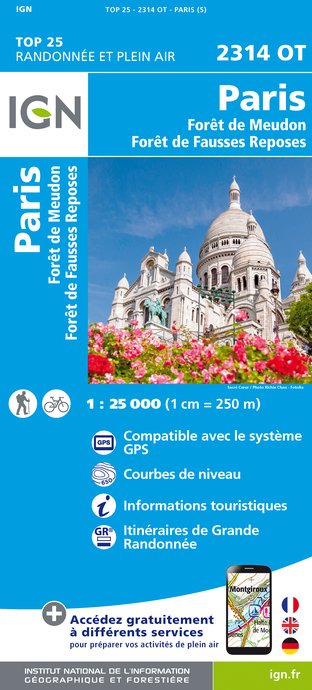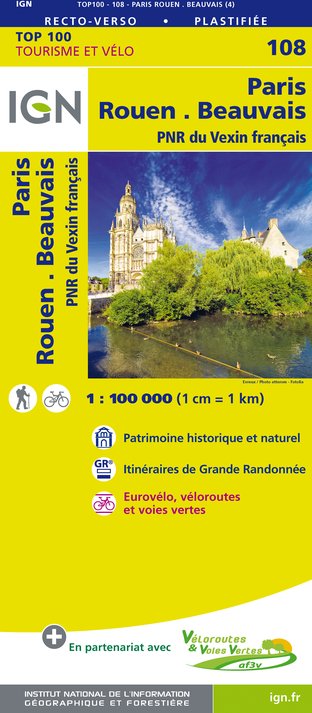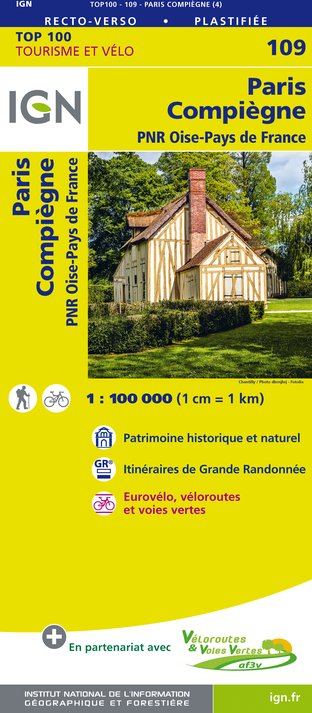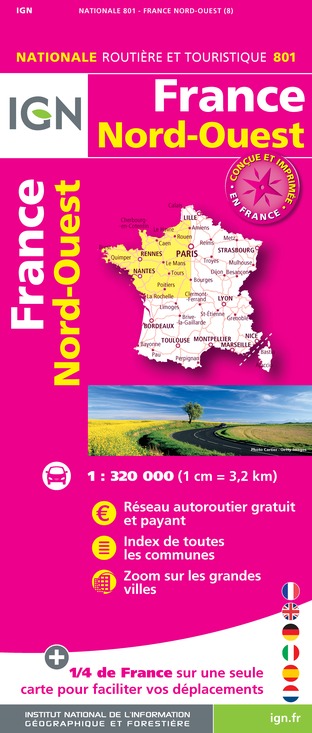Alerta
Alertas
Tipo de práctica
En barco
A pie
En bicicleta
Presentación
Mapa
Puntos de interés
Resumen de Cirkwi
Calificaciones y reseñas
Ver alrededor
París en Batobus



Crédito : Batobus
El resumen de Cirkwi
Explora París en barco: Descubre la ruta del Batobus
Curado por Balades Fluviales Fabienne Lemoine Fondateur, el tour del Batobus ofrece una experiencia parisina única mientras te deslizas por el Sena. Deja atrás el bullicio típico de los tours urbanos para embarcarte en un viaje sereno que conecta lugares emblemáticos con la facilidad del transporte fluvial. Este viaje te llevará a través de los latidos del corazón parisino, desde la majestuosa Torre Eiffel hasta el faro cultural de Trocadéro. Es una invitación a observar las maravillas arquitectónicas de París y el ritmo del río, una narrativa diseñada para aquellos que desean descubrir la esencia de la ciudad en tranquilidad.
Detalles técnicos del itinerario
Un circuito completo abarca más de 9.8 kilómetros, con fluctuaciones de altitud que van sutilmente entre los 27 y los 30 metros. El recorrido presenta cambios de elevación mínimos, precisamente 11 metros, lo que lo hace asombrosamente plano. Estas métricas resaltan un camino accesible y tranquilo, ideal para visitantes de todas las edades, prometiendo una exploración cómoda de las pintorescas orillas del río Sena y las joyas arquitectónicas de París sin esfuerzo físico.
Consejos estacionales para el viaje en Batobus
Sin importar la estación, la experiencia del Batobus es encantadora. Sin embargo, la primavera y el otoño ofrecen un clima suave, lo que mejora tus paseos por los muelles de manera relajada. Para los viajeros de verano, la protección solar y la hidratación son clave, ya que el atractivo del río es mayor bajo el resplandor del sol. Los viajeros de invierno deben vestirse abrigados, asegurándose de que el frío no reste belleza a las iluminadas noches de París. En cuanto a la seguridad, siempre mantén la atención en tus alrededores y sigue las instrucciones de la tripulación, especialmente al subir o bajar del barco.
París, corazón de la cultura e historia francesas
París no es solo la capital de Francia; es un tapiz histórico que ha influido en la cultura global, el arte y la política durante siglos. Ubicada dentro de la región de Île-de-France, sus riberas en el río Sena han sido testigos de momentos decisivos, desde la Revolución Francesa hasta las revolucionarias Exposiciones Universales. Esta ciudad, que encarna la libertad, la creatividad y la resiliencia, se presenta de manera majestuosa mientras uno navega por su arteria principal, el Sena, presenciando monumentos que narran historias de triunfo, tragedia y transformación.
Entendiendo el clima de París para los viajeros
París disfruta de un clima templado, caracterizado por inviernos suaves y veranos agradablemente cálidos. La ciudad experimenta lluvias de manera uniforme durante todo el año, con ocasional caída de nieve en invierno. El mejor momento para disfrutar de un tour en Batobus, considerando el clima, sería a fines de primavera a principios de otoño (de mayo a septiembre), cuando el clima es más propicio para pasear y disfrutar de la cubierta abierta, con mínimas interrupciones por lluvia y una cómoda gama de temperaturas que facilita exploraciones extensas de las orillas del río y los puntos de referencia adyacentes.
Curado por Balades Fluviales Fabienne Lemoine Fondateur, el tour del Batobus ofrece una experiencia parisina única mientras te deslizas por el Sena. Deja atrás el bullicio típico de los tours urbanos para embarcarte en un viaje sereno que conecta lugares emblemáticos con la facilidad del transporte fluvial. Este viaje te llevará a través de los latidos del corazón parisino, desde la majestuosa Torre Eiffel hasta el faro cultural de Trocadéro. Es una invitación a observar las maravillas arquitectónicas de París y el ritmo del río, una narrativa diseñada para aquellos que desean descubrir la esencia de la ciudad en tranquilidad.
Detalles técnicos del itinerario
Un circuito completo abarca más de 9.8 kilómetros, con fluctuaciones de altitud que van sutilmente entre los 27 y los 30 metros. El recorrido presenta cambios de elevación mínimos, precisamente 11 metros, lo que lo hace asombrosamente plano. Estas métricas resaltan un camino accesible y tranquilo, ideal para visitantes de todas las edades, prometiendo una exploración cómoda de las pintorescas orillas del río Sena y las joyas arquitectónicas de París sin esfuerzo físico.
Consejos estacionales para el viaje en Batobus
Sin importar la estación, la experiencia del Batobus es encantadora. Sin embargo, la primavera y el otoño ofrecen un clima suave, lo que mejora tus paseos por los muelles de manera relajada. Para los viajeros de verano, la protección solar y la hidratación son clave, ya que el atractivo del río es mayor bajo el resplandor del sol. Los viajeros de invierno deben vestirse abrigados, asegurándose de que el frío no reste belleza a las iluminadas noches de París. En cuanto a la seguridad, siempre mantén la atención en tus alrededores y sigue las instrucciones de la tripulación, especialmente al subir o bajar del barco.
París, corazón de la cultura e historia francesas
París no es solo la capital de Francia; es un tapiz histórico que ha influido en la cultura global, el arte y la política durante siglos. Ubicada dentro de la región de Île-de-France, sus riberas en el río Sena han sido testigos de momentos decisivos, desde la Revolución Francesa hasta las revolucionarias Exposiciones Universales. Esta ciudad, que encarna la libertad, la creatividad y la resiliencia, se presenta de manera majestuosa mientras uno navega por su arteria principal, el Sena, presenciando monumentos que narran historias de triunfo, tragedia y transformación.
Entendiendo el clima de París para los viajeros
París disfruta de un clima templado, caracterizado por inviernos suaves y veranos agradablemente cálidos. La ciudad experimenta lluvias de manera uniforme durante todo el año, con ocasional caída de nieve en invierno. El mejor momento para disfrutar de un tour en Batobus, considerando el clima, sería a fines de primavera a principios de otoño (de mayo a septiembre), cuando el clima es más propicio para pasear y disfrutar de la cubierta abierta, con mínimas interrupciones por lluvia y una cómoda gama de temperaturas que facilita exploraciones extensas de las orillas del río y los puntos de referencia adyacentes.
Generado automáticamente.
IGN tarjetas

2314OT - PARIS FORÊT DE MEUDON FORÊT DE FAUSSES REPOSES
Editora : IGN
Recopilación : TOP 25 ET SÉRIE BLEUE
Escalera : 1:25 000
13.90€

190 PARIS CHANTILLY FONTAINEBLEAU
Editora : IGN
Recopilación : TOP 100
Escalera : 1:100 000
8.40€

118 PARIS CHARTRES PNR DE LA HAUTE VALLÉE DE CHEVREUSE
Editora : IGN
Recopilación : TOP 100
Escalera : 1:100 000
8.40€

108 PARIS ROUEN BEAUVAIS PNR DU VEXIN FRANÇAIS
Editora : IGN
Recopilación : TOP 100
Escalera : 1:100 000
8.40€

109 PARIS COMPIÈGNE PNR OISE-PAYS DE FRANCE
Editora : IGN
Recopilación : TOP 100
Escalera : 1:100 000
8.40€

D75-95 ÎLE-DE-FRANCE OUEST
Editora : IGN
Recopilación : CARTES DÉPARTEMENTALES IGN
Escalera : 1:150 000
5.90€

D77 SEINE-ET-MARNE
Editora : IGN
Recopilación : CARTES DÉPARTEMENTALES IGN
Escalera : 1:150 000
5.90€

D28 EURE-ET-LOIR
Editora : IGN
Recopilación : CARTES DÉPARTEMENTALES IGN
Escalera : 1:150 000
5.90€

NR01 HAUTS-DE-FRANCE
Editora : IGN
Recopilación : CARTES RÉGIONALES IGN
Escalera : 1:250 000
6.80€

NR08 CENTRE-VAL DE LOIRE
Editora : IGN
Recopilación : CARTES RÉGIONALES IGN
Escalera : 1:250 000
6.80€

NR03 ÍLE DE FRANCE
Editora : IGN
Recopilación : CARTES RÉGIONALES IGN
Escalera : 1:250 000
6.80€

801 FRANCE NORD OUEST
Editora : IGN
Recopilación : CARTES NATIONALES IGN
Escalera : 1:320 000
6.10€

EUROPE
Editora : IGN
Recopilación : DÉCOUVERTE DES PAYS DU MONDE IGN
Escalera : 1:2 500 000
7.00€
Informaciónes técnicas
En barco
Dificultad
No especificada
Dist.
9.9 km
Tipo de práctica
En barco
A pie
En bicicleta
Mostrar más
Perfil altimétrico
Punto de partida
75007
Paris
Lat : 48.861687Lng : 2.295842
Puntos de interés
Autor de los datos
Calificaciones y reseñas
Para ver alrededor








